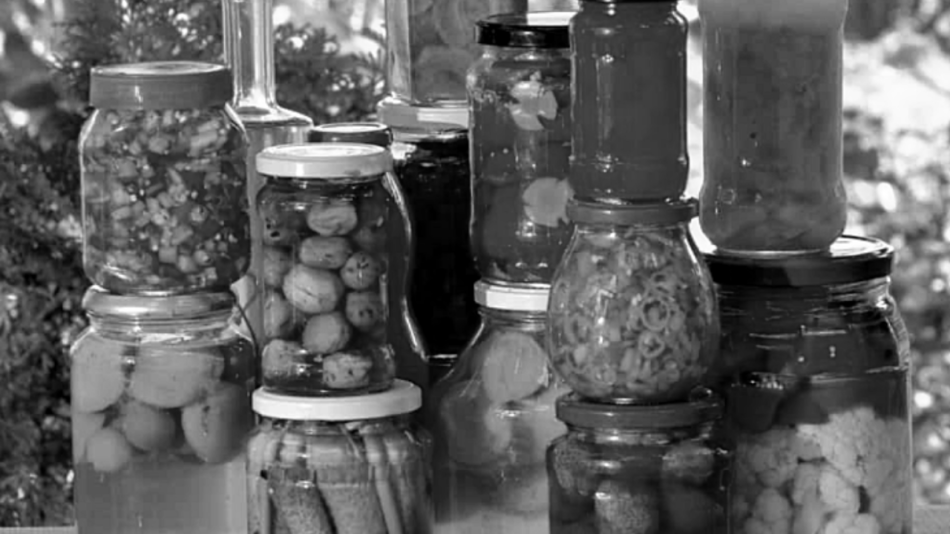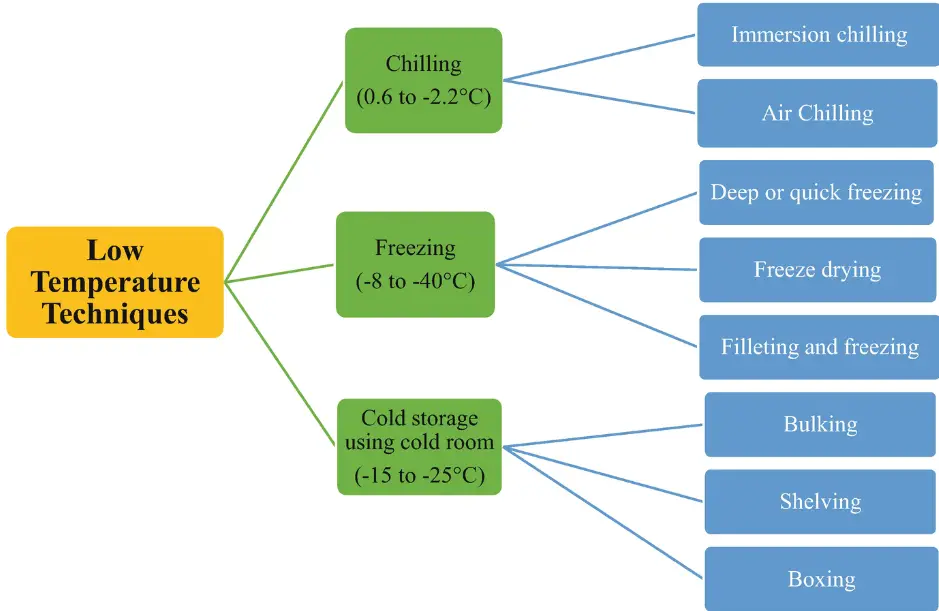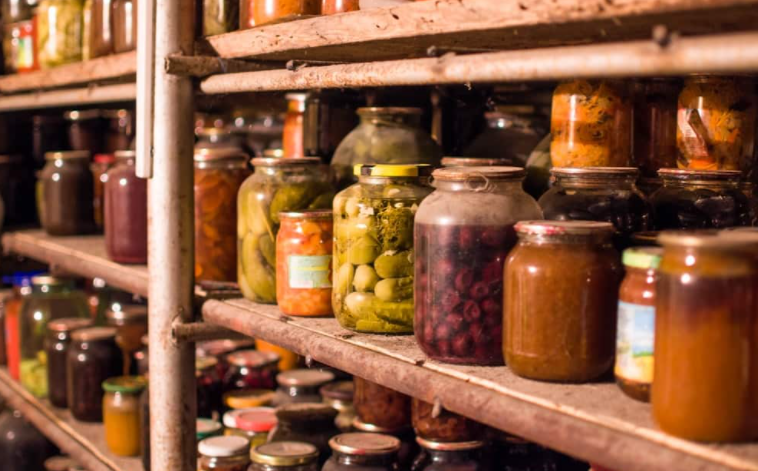
Have you ever considered how goods made in restaurants and fast-food joints are stored? If you haven’t already, this article was designed specifically for you. In this post, let’s take a look at the types of food storage methods used in storing food. These food storage methods are used to preserve food to maintain its taste, nutrition, and life span. So, what food storage methods ensure adequate food supply for the days ahead?
Related Article: Best Food Storage Ideas – 4 Types of Food Storage
The different food storage methods include food canning, dry and dehydrated food storage, refrigerated and frozen food storage, fermentation food storage, pickling, and some factors that affect each of these methods.
Food storage methods: The benefits and the drawbacks
There are various methods for storing food, each with its own advantages and disadvantages. Depending on your approach, there are a few things to consider.
1. Canning
This is a low-cost method of storing quality food at home and one of the modern methods of food preservation. Tomato sauce, veggies, jams & jellies, and infant purees are all examples of canned foods.
The fundamental procedures in food canning involve properly washing the fresh products you will use, peeling, and hot packing. Add acids such as lemon juice or vinegar if the food is not acidic, and utilize lidded containers. The canned jars are next processed for a proper period using boiling water (for vegetables and fruits that are acidic) or a pressure canner (for vegetables and fruits that have low acidic levels). To guarantee safety, this helps to inhibit bacterial development and destroy any diseases.
Home canning can save money and eliminate the risk of BPA contamination because you’ll use glass mason jars instead of plastic or BPA-lined jars.
Canned foods also have a longer shelf life, although some nutritional content is lost. During the heating process, around 30-50 percent of thiamin, riboflavin, and vitamins A, and C are lost, with a further 5-20 percent loss yearly. Less sensitive vitamins last longer and are found in somewhat lower concentrations than fresh food. Vegetables may be tough if handled and canned rapidly, and they can retain much of their nutritional value. Also, you don’t have to prepare anything with canned goods before consuming them; you may consume them straight from the can.
Risks and downsides of canning
Canning also has certain dangers that you need to be aware of.
- To avoid infection, home canning needs a sterile atmosphere.
- To avoid diseases like botulism, canned goods must be kept at the proper temperatures and with airtight lids.
- To put it another way, don’t just follow the directions in this article.
- To guarantee you’re preserving food rather than armies of dangerous bacteria, follow these USDA rules and pay attention to hygiene, time, and temperature.
Canning, on the other hand, has a few drawbacks.
- In addition to losing some flavor and nutrition over time, canned foods such as jams and jellies sometimes include a lot of added sugar. This adds health concerns and risks.
- Mold can form on canned goods, particularly on the surfaces of high-sugar foodstuffs like jams and jellies, so be cautious.
- Mold may create poisonous chemicals known as mycotoxins, which have the potential to cause cancer.
- Mold on canned food surfaces is usually bright and simple to spot.
- Mold may be avoided by using suitable heat processing and air-tight sealing techniques.
- All the seals must be tested before storing the canned jars in your cupboard or garage.

2. Freezing
Many foods may be stored using this frozen food method, which is also one of the modern methods of food preservation. Soups, oats, and coffee grounds may all be frozen, as well as vegetarian burger patties, chopped fruits, and blanched veggies.
A well-kept freezer will keep food for a long time, after which you may safely defrost it (in the fridge or under cold water only) and prepare it as desired. Foods you make at home and thereafter freeze are nearly always healthier for you in terms of nutrition than frozen meals from the grocery store.
Although there are a few hazards associated with freezing, there are only a few things you need to keep in mind. Everything in the freezer is susceptible to freezer burn, which occurs when air comes into contact with the food’s top and appears as grayish-brown patches. This does not make the food dangerous to consume, but it does cause it to get dry in some places.
When you defrost the food, you may chop these portions off. While some foods retain their flavor after freezing, others undergo dramatic, and often unpleasant, textural changes.
And frozen goods don’t have an endless storage life, as much as we would like them. After a lengthy period, foods like soups, stews, plants, and fruits may deteriorate. Write in permanent marker the date on a container and use or cast very old specimens regularly to avoid keeping or forgetting items in your freezer for a long time and risking spoiling. We suggest putting the most recently frozen things at the back of the freezer and defrosting and consuming the older stuff first. This promotes a natural cycle and reduces food waste.
3. Drying or dehydration
Fruits, vegetables, and herbs benefit greatly from this preservation technique and are also one of the traditional food storage methods. Food that has been dried tends to have a stronger flavor, costs relatively less, and is easier to store due to its smaller size.
What is the mechanism behind it? Dehydration depletes the water content of fresh foods, preventing bacterial development. Home-dried foods should have a moisture level of about 20% or less. You may accomplish it by hanging bunches of fresh herbs (well, if you’re in high humidity), using a commercial dehydrator, drying ovens, or even utilizing the sun to dry your food. To help preserve some fruits and vegetables, blanch them (dunk them quickly in hot water) before drying them.
Dehydration, on the other hand, has certain disadvantages. While many nutrients stay rather stable after dehydration, vitamins A, C, and thiamin are heat (if boiled or cooked in the oven) and air-sensitive.
Electric dehydrators also consume a lot of electricity, so you may save money by utilizing one of the alternative home-drying techniques. Dehydrating food takes a long time — typically over ten hours — so be ready to be patient and plan accordingly if you decide to use this approach. Preparing goods for drying takes time as well. Cutting and coring fruits and putting them on a drying rack are examples of tasks that may require physical effort.

4. Fermentation
Fermenting foods is one of the traditional food storage methods, and it is a fantastic method to increase your bacteria (prebiotic) intake, which is beneficial to your digestive tract and health. Lacto-fermentation, a bacterial activity that retains and enhances nutrient content in food, is the first step in the fermentation process. Chopping, grating, preparing your raw food, choosing the culture to use (usually salt, whey, or a starting culture), making and adding brine, and storing everything in a sealed container in a cold climate are the fundamental procedures.
Fermentation necessitates caution since food might spoil if you don’t utilize fresh vegetables or distilled or pure water throughout the procedure. Fermentation also consumes a lot of salt, which helps to preserve food by drawing out the water content and inhibiting bacterial growth. For many people, this is a disadvantage. Fresh cabbage, kimchi, and other salty fermented vegetables can be used as a “salt supply” in various dishes.
5. Pickling
Pickling, like fermentation, may be done on a variety of vegetables other than cucumbers. Have you ever tried green beans, beets, cauliflower, peppers, cabbage, and other fruits, including lemon or mangoes are all widely pickled dishes?
Pickling is a way of restoring food in a high-acid solution. This can be done naturally, or you can add vinegar and salt to the solution. Sugar can also be used sometimes to keep food from spoiling and increase its storage life. Most pickled food combinations are extremely attractive and make excellent presents! Pickling at home requires only a few ingredients
6. Cold storage
This is a very popular method that most people use to store food products and one of the traditional food storage methods. This can be done using a refrigerator or a root cellar. Some common examples of cold storage include apples, pears, celery, and so on.
Cold storage products such as pears, apples, root vegetables, celery, and cabbage can survive for several months. To achieve the longest storage life from your food, ensure you know and understand the optimal temperatures and conditions for food storage. Apples, for instance, should be kept in a moist, permeable bag at slightly above freezing. Make sure to put your fresh produce in areas where it cannot easily be ruined. Most fruits like apples, blueberries, and other vegetables release ethylene gas.
To keep fruits and vegetables as fresh as possible, they must be kept in specific ways.
- Apricots, green onions, strawberries, grapes, and asparagus should all be put in the fridge immediately.
- Avocados, kiwis, peaches, and pears should all mature on the counter before being stored in the refrigerator.
- Pomegranates, ginger, mandarin oranges, and jicama should never be refrigerated and this is because these taste best at room temperature.
Other things to consider when using cold storage
It’s also crucial to keep the right quantity of moisture to avoid drying out, wilting, or early mold. Rather than keeping vegetables on the shelf or countertop, put them in containers with holes to encourage air circulation.
If your refrigerator has a fan, which most do, it might dry out your food. This impact is usually mitigated in the produce drawer. If not stored in a bag, container, or otherwise shielded from the drying impact of the fan, foods placed unsecured inside the fridge and outside of the produce drawer will dry out.
Choosing attractive food at the shop also helps to avoid premature spoiling. If you do not intend to consume them immediately, avoid avocados and bananas that are already mushy or spotted. Ensure your product isn’t damaged, discolored, pierced, or broken before eating it.
Also, waiting until you are ready to store, prepare or consume is necessary, as pre-wash mold development can be easily attained during storage. Finally, if you cultivate your food, ensure it is ripe. You should also avoid picking it up too early or too late.
The importance of proper food storage
Here are some of the advantages of mastering food storage:
- You save money by reducing food waste, which is also good for the environment.
- Fruits and vegetables will retain their freshness for a longer period.
- You can save money by purchasing items in bulk or when they are in season. You can use them for a longer amount of time as well.
- Most food storage solutions do not require electricity, so you can eat healthily even when you are experiencing a power outage or camping.
- Fermenting, a traditional food preservation technique, may supplement your diet with beneficial microorganisms.
- If you can’t consume them immediately, perishable and semi-perishable goods should be kept or preserved.
Factors affecting the shelf life of food
The following are the primary factors affecting the shelf life of food while in storage:
- Some foods, like strawberries, can degrade within a single day, while some foods, like potatoes, will take months to degrade when properly stored.
- The food’s freshness and ripeness at the time of purchase. This is partly determined by where it was cultivated and how long it remained in transit. Even if you purchased it from a grocery shop, it might have been picked recently.
- Before you purchased it, how long and at what temperature it was kept? This can include the countertop, basement, freezer, refrigerator, or basement.
- The humidity level in the storage areas should also be checked. The humidity varies depending on several factors, for example, the location of your house and your actual geographical region.
Glass, plastic, foil, or linen are all examples of storage containers or packaging for food.
Three food types
Every food may be divided into one of three classes requiring various storage strategies.
1. Foods that perish
These contain many raw fruit and vegetables, including meat, milk, and eggs. All prepared foods are regarded as peregrinated food. Perishable products must be stored at refrigerator or freezer temperature to store these items for a long period.1. Perishable Foods. Many perishable items should be consumed within three to seven days if chilled (less for many animal products).
2. Semi-perishable foods
Semi-perishable foods might spoil fast or have a long shelf life based on how they’re kept and managed. Semi-perishable items include flour, grains, dried fruits, and dry mixes. Semi-perishable goods can be kept unspoiled for several months to a year if properly stored and managed, such as in a clean, vacuum-sealed bag. Some items can be frozen and kept for a longer time.
3. Staple or non-perishable foods
Staple or Non-perishable Foods: Most nonperishable foods are stapled foods. Examples of these kinds of food include spices, dried beans, and some canned goods. Such foods wonts spoil if handled correctly, they will only spoil if handled carelessly. However, even when kept in optimal circumstances, they might lose quality with time.
Tips when storing food types and examples
- Keep it in the Refrigerator—assuming you have access to electricity or a backup power source.
- Keep the food in a Freezer—assuming you have access to electricity or a backup power source.
- Use a root cellar. A root cellar is a cold, dark, damp storage space for potatoes, some fruits, winter squash, and other root vegetables.
- Keep certain foods in the ground until you need it
- Leave on the plant/tree as long as feasible or till needed.
- If at all possible, avoid butchering animals until the meat is required.
- Plan to grow as much as possible then consumes as much as possible.
Purchase canned goods or make your own.
Dry/Bulk— Legumes, Pasta, Spices, Whole Grains, Sweeteners, or Processed
The above-mentioned food storage considerations apply here.
This entire food category must be kept in an airtight container to keep moisture and oxygen out. To begin storage, each item should be frozen for 10 days at zero degrees or colder. This destroys insect eggs, preventing them from hatching and attacking/contaminating the meal. If properly preserved, these foods can be kept indefinitely.
Frozen—Meat, milk, seeds, vegetable, and fruit
Because freezing space and electricity are one of the easiest techniques for storing food. If you use this approach, you must have backup power and an alternate cooking method in case where you run out of power or you can no longer use the freezer.
Conclusion
Food may be stored in various ways once harvested or slaughtered. Such food storage methods can be traced back to ancient times. Drying, chilling, and fermentation are some of the earliest food preservation techniques. Canning, pasteurization, freezing, irradiation, and chemical addition are all examples of modern methods of food preservation. Modern food preservation has benefited greatly from advancements in storing and packing food materials.